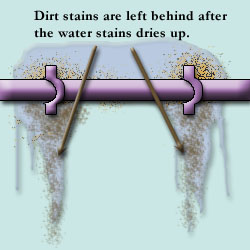Case 1
- Introduction
- Causes of Defects
- Good Practices
- Standards
- Maintenance and Diagnostics
- Remedial
- Similar Cases
- References
Cause of Defects



The installation of electrical fixtures and ducts on the surface of an external wall will often result in dirt being able to accumulate at the crevices and corners create (Figure 1a to c).
When rain water runs over such areas, the dirt particles are carried along but due to the relatively rough texture of a painted wall, the dirt particles can be easily deposited when the volume and rate of rain water flow is too small to carry the dirt particles to the bottom of the wall.
The intensity of stain streaks formed corresponds to the area of the surfaces where dirt can gather. In this case, the ducts offers a smaller area for the dirt particles to accumulate than the light fixture and thus staining is more intense below the light fixture.
Degree of exposure to driven rain depends on:
- Direction of building facade with respect to the direction of the rain
- topographical condition or basic exposure of site
- extent of shielding by other buildings and direction and pressure of wind
- Influence of wind and nature of falling rain
- Details of building design
| Pollutants | Examples | Sizes | Sources | Possible effects |
| Aerosols | Sulphur dioxide (SO2) | Gaseous | Burning of fuels | Formation of acid rain. Reaction with water and other materials to form sulphates and chlorides to cause destruction to façade materials. |
| Soot or black smoke | Smoke from tobacco, coal, fuel oil, metallurgical industry | <1 pm | Imperfect combustion | Transported by air and deposited on facades to cause stains |
| Coarse particulate matter | Ash, dust, rock debris, mineral dust. | >1 pm | Unburnt fuel and dust from roads and industries | Transported by air for short distances and deposited more easily on horizontal or sloping surfaces to form stains. |
Table 1: Sources of Pollutants
Staining on a facade has a lot to do with the pattern of rainwater runoff, which in turn is dependent on the facade configuration, colour, texture, as well as the “roughness” and “water absorption” properties of the materials used:

